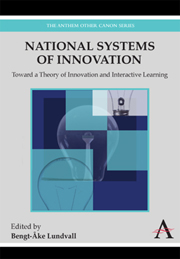Book contents
- Frontmatter
- Contents
- List of Tables
- List of Figures
- Preface
- 1 Introduction
- Part I Toward a New Approach to National Systems of Innovation
- Part II A Closer Look at National Systems of Innovation
- 5 Work Organisation and the Innovation Design Dilemma
- 6 Innovation and the Development of Industrial Networks
- 7 The Public Sector as a Pacer in National Systems of Innovation
- 8 The Role of Finance in National Systems of Innovation
- 9 Formal Scientific and Technical Institutions in the National System of Innovation
- Part III Opening National Systems of Innovation: Specialisation, Multinational Corporations and Integration
- Notes
- References
7 - The Public Sector as a Pacer in National Systems of Innovation
from Part II - A Closer Look at National Systems of Innovation
Published online by Cambridge University Press: 05 March 2012
- Frontmatter
- Contents
- List of Tables
- List of Figures
- Preface
- 1 Introduction
- Part I Toward a New Approach to National Systems of Innovation
- Part II A Closer Look at National Systems of Innovation
- 5 Work Organisation and the Innovation Design Dilemma
- 6 Innovation and the Development of Industrial Networks
- 7 The Public Sector as a Pacer in National Systems of Innovation
- 8 The Role of Finance in National Systems of Innovation
- 9 Formal Scientific and Technical Institutions in the National System of Innovation
- Part III Opening National Systems of Innovation: Specialisation, Multinational Corporations and Integration
- Notes
- References
Summary
Introduction
In a period characterised by increasing internationalisation and transnational political regulation the traditional role of national government in relation to industrial policy and technology policy is challenged. In this context it becomes important to understand which role the public sector has played in the past and can play in the future in relation to innovation and technical change within nations.
In many ways, the central role of the public sector in creating, maintaining and developing modern national systems of innovation is comparable with the one played by a pacer in a bicycle race. If public sector demand in both qualitative and quantitative terms races ahead it loses contact with the innovative capability of national suppliers. On the other hand, if public sector demand slows down too much, national suppliers may slow down their process of renewal and stick to pure routinising. As optimal pacing in a bicycle race requires a mutual understanding between the racing cyclist and the pacer, optimal pacing leading to an upgrading of national systems of innovation requires a mutual understanding between the public and private participants in interactive learning and searching processes.
In many countries the public sector actually tries to play the role of a pacer via technology programmes, public procurement policies, and so on. Sometimes it succeeds, and sometimes it fails or comes out with only modest success.
- Type
- Chapter
- Information
- National Systems of InnovationToward a Theory of Innovation and Interactive Learning, pp. 133 - 150Publisher: Anthem PressPrint publication year: 2010
- 10
- Cited by



